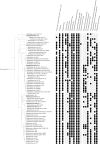Survival strategies of aerobic methanotrophs under hypoxia in methanogenic lake sediments
- PMID: 38956741
- PMCID: PMC11218250
- DOI: 10.1186/s40793-024-00586-1
Survival strategies of aerobic methanotrophs under hypoxia in methanogenic lake sediments
Erratum in
-
Correction: Survival strategies of aerobic methanotrophs under hypoxia in methanogenic lake sediments.Environ Microbiome. 2024 Sep 12;19(1):70. doi: 10.1186/s40793-024-00609-x. Environ Microbiome. 2024. PMID: 39267154 Free PMC article. No abstract available.
Abstract
Background: Microbial methane oxidation, methanotrophy, plays a crucial role in mitigating the release of the potent greenhouse gas methane from aquatic systems. While aerobic methanotrophy is a well-established process in oxygen-rich environments, emerging evidence suggests their activity in hypoxic conditions. However, the adaptability of these methanotrophs to such environments has remained poorly understood. Here, we explored the genetic adaptability of aerobic methanotrophs to hypoxia in the methanogenic sediments of Lake Kinneret (LK). These LK methanogenic sediments, situated below the oxidic and sulfidic zones, were previously characterized by methane oxidation coupled with iron reduction via the involvement of aerobic methanotrophs.
Results: In order to explore the adaptation of the methanotrophs to hypoxia, we conducted two experiments using LK sediments as inoculum: (i) an aerobic "classical" methanotrophic enrichment with ambient air employing DNA stable isotope probing (DNA-SIP) and (ii) hypoxic methanotrophic enrichment with repeated spiking of 1% oxygen. Analysis of 16S rRNA gene amplicons revealed the enrichment of Methylococcales methanotrophs, being up to a third of the enriched community. Methylobacter, Methylogaea, and Methylomonas were prominent in the aerobic experiment, while hypoxic conditions enriched primarily Methylomonas. Using metagenomics sequencing of DNA extracted from these experiments, we curated five Methylococcales metagenome-assembled genomes (MAGs) and evaluated the genetic basis for their survival in hypoxic environments. A comparative analysis with an additional 62 Methylococcales genomes from various environments highlighted several core genetic adaptations to hypoxia found in most examined Methylococcales genomes, including high-affinity cytochrome oxidases, oxygen-binding proteins, fermentation-based methane oxidation, motility, and glycogen use. We also found that some Methylococcales, including LK Methylococcales, may denitrify, while metals and humic substances may also serve as electron acceptors alternative to oxygen. Outer membrane multi-heme cytochromes and riboflavin were identified as potential mediators for the utilization of metals and humic material. These diverse mechanisms suggest the ability of methanotrophs to thrive in ecological niches previously thought inhospitable for their growth.
Conclusions: Our study sheds light on the ability of enriched Methylococcales methanotrophs from methanogenic LK sediments to survive under hypoxia. Genomic analysis revealed a spectrum of genetic capabilities, potentially enabling these methanotrophs to function. The identified mechanisms, such as those enabling the use of alternative electron acceptors, expand our understanding of methanotroph resilience in diverse ecological settings. These findings contribute to the broader knowledge of microbial methane oxidation and have implications for understanding and potential contribution methanotrophs may have in mitigating methane emissions in various environmental conditions.
Keywords: Methylobacter; Methylomonas; Aerobic methanotrophy; Hypoxia; Lake sediment; Methanogenic zone.
© 2024. The Author(s).
Conflict of interest statement
The authors declare that they have no competing interests.
Figures




References
-
- Kelly DP, Wood AP. The chemolithotrophic prokaryotes. Prokaryotes. 2006. 10.1007/0-387-30742-7_15.10.1007/0-387-30742-7_15 - DOI
-
- Nordi KÁ, Thamdrup B, Schubert CJ. Anaerobic oxidation of methane in an iron-rich Danish freshwater lake sediment. Limnol Oceanogr. 2013;58:546–54.10.4319/lo.2013.58.2.0546 - DOI
Grants and funding
LinkOut - more resources
Full Text Sources
Miscellaneous
